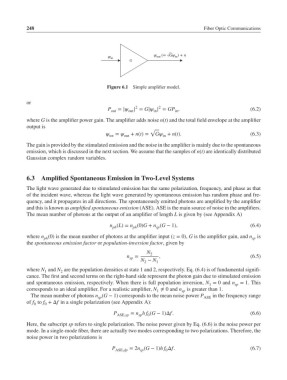Page 267 - Fiber Optic Communications Fund
P. 267
248 Fiber Optic Communications
ψ out (= Gψ in ) + n
ψ in
G
Figure 6.1 Simple amplifier model.
or
2
2
P out = | | = G| | = GP , (6.2)
in
out
in
where G is the amplifier power gain. The amplifier adds noise n(t) and the total field envelope at the amplifier
output is
√
tot = out + n(t)= G + n(t). (6.3)
in
The gain is provided by the stimulated emission and the noise in the amplifier is mainly due to the spontaneous
emission, which is discussed in the next section. We assume that the samples of n(t) are identically distributed
Gaussian complex random variables.
6.3 Amplified Spontaneous Emission in Two-Level Systems
The light wave generated due to stimulated emission has the same polarization, frequency, and phase as that
of the incident wave, whereas the light wave generated by spontaneous emission has random phase and fre-
quency, and it propagates in all directions. The spontaneously emitted photons are amplified by the amplifier
and this is known as amplified spontaneous emission (ASE). ASE is the main source of noise in the amplifiers.
The mean number of photons at the output of an amplifier of length L is given by (see Appendix A)
n (L)= n (0)G + n (G − 1), (6.4)
ph ph sp
where n (0) is the mean number of photons at the amplifier input (z = 0), G is the amplifier gain, and n is
sp
ph
the spontaneous emission factor or population-inversion factor, given by
N 2
n = , (6.5)
sp
N − N
2 1
where N and N are the population densities at state 1 and 2, respectively. Eq. (6.4) is of fundamental signifi-
2
1
cance. The first and second terms on the right-hand side represent the photon gain due to stimulated emission
and spontaneous emission, respectively. When there is full population inversion, N = 0 and n = 1. This
1 sp
corresponds to an ideal amplifier. For a realistic amplifier, N ≠ 0 and n is greater than 1.
1 sp
The mean number of photons n (G − 1) corresponds to the mean noise power P in the frequency range
sp ASE
of f to f +Δf in a single polarization (see Appendix A):
0 0
P ASE,sp = n hf (G − 1)Δf. (6.6)
sp
0
Here, the subscript sp refers to single polarization. The noise power given by Eq. (6.6) is the noise power per
mode. In a single-mode fiber, there are actually two modes corresponding to two polarizations. Therefore, the
noise power in two polarizations is
P ASE,dp = 2n (G − 1)hf Δf. (6.7)
sp
0

